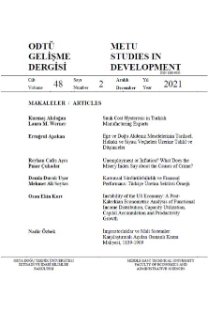Keynesian and Neoclassical Closures in an Agent-Based Context
İktisadi Birim Temelli Analiz Bağlamında Keynesgil ve Neoklasik Kapanışlar Üzerine
___
- ABDALLAH, S. and LESSER, V. (2007), “Multiagent Reinforcement Learning and Self-Organization in a Network of Agents”, in Proceedings of the Sixth International Joint Conference on Autonomous Agents and Multi-Agent Systems, Honolulu.
- ARTHUR, W. B., DURLAUF, S. and LANE, D. (1997), The Economy as an Evolving Complex System, Volume 2, New York: Addison-Wesley.
- AXTELL, R. (1999), “The Emergence of Firms In A Population of Agents”, http://www.brookings.edu/es/dynamics/papers/firms/firmspage.htm.
- AXTELL, R., EPSTEIN, J. and YOUNG, P. (2001), “The Emergence of Classes in A Multi-Agent Bargaining Model”, in S. Durlauf and P. Young (eds.), Social Dynamics, Cambridge, MA: MIT Press, 191-212.
- BACHA, E. L. (1990), “A Three-Gap Model of Foreign Transfers and the GDP Growth Rate in Developing Countries”, Journal of Development Economics, 32 (2), 279-96.
- BARABÁSI, A.-L. (2003), Linked: How Everything Is Connected to Everything Else and What It Means for Business, Science, and Everyday Life, Penguin Group (USA) Inc.: Plume Books.
- BARABÁSI, A.-L. and ALBERT, R. (1999), “Emergence of Scaling in Random Networks”, Science, 286, 509-12.
- BASU, K. (1994), “The Traveler’s Dilemma: Paradoxes of Rationality in Game Theory”, American Economic Review, 84 (2), 391-5.
- BOUTILIER, C., SHOHAM, Y. and WELLMAN, M. P. (1997), “Economic Principles of Multiagent Systems”, Artificial Intelligence, 94 (1-2), 1-6.
- DEBREU, G. (1974), “Excess Demand Functions”, Journal of Mathematical Economics, 1, 15-21.
- DESSALLES, J. L., FERBER, J. and PHAN, D. (2007), “Emergence in Agent Based Computational Social Science: Conceptual, Formal and Diagrammatic Analysis”,http://perso.univ-rennes1.fr/denis.phan/papers/DessallesFerberPhan 2007.pdf.
- DEWATRIPONT, M. and MICHEL, G. (1987), “On Closure Rules, Homogeneity and Dynamics in Applied General Equilibrium Models”, Journal of Development Economics, 26 (1), 65-78.
- DURLAUF, S. N. (1996), “A Theory of Persistent Income Inequality”, Journal of Economic Growth, 1 (1), 75-93. ————(1999), “How Can Statistical Mechanics Contribute to Social Sciences?”, prepared for the Proceedings of the National Academy of Sciences.
- DUTT, A. K. (2007), “Heterodox Development Economics and the Role of Aggregate Demand”, Centre for Development Studies, University of Glasgow, http://www.eurovirology.com/centres/developmentstudies/conference2007/papers/.
- EPSTEIN, J. and AXTELL R. (1996), Growing Artificial Societies: Social Science from the Bottom Up, Washington, DC: Brookings Institution Press.
- GATTI, D. D., GAFFEO, E., GALLEGATI M., GIULIONI, G. and PALESTRINI, A. (2008), Emergent Macroeconomics, New Economic Windows. Frankfurt: Springer.
- GIBSON, B. (2007), “A Multi-Agent Systems Approach to Microeconomic Foundations of Macro”, University of Massachusetts, Department of Economics Working Paper Series.
- HENRICH, J., BOYD, R., BOWLES, S., CAMERER, C. FEHR, E. and GINTIS, H. (2004), Foundations of Human Sociality: Economic Experiments and Ethnographic Evidence from Fifteen Small-Scale Societies, Oxford: Oxford University Press.
- HOLLAND, J. (1998), Emergence: From Chaos to Order, New York, NY: Basic Books. LUCAS, R. E. (1976), “Econometric Policy Evaluation: A Critique”, Carnegie-Rochester Conference Series on Public Policy, 1 (1), 19-46.
- LUCAS, R. E. and SARGENT, T. J. (1978), “After Keynesian Macroeconomics”, in After the Phillips Curve: Persistence of High Inflation and High Unemployment, Boston, MA: Federal Reserve Bank, 49-72.
- MACHTA, B. and MACHTA, J. (2005), “Parallel Dynamics and Computational Complexity of Network Growth Models”, Physical Review E 71, 1-9. http://www.citebase.org/abstract?id=oai:arXiv.org:cond-mat/0408372.
- PLOSSER, C. (1989), “Understanding Real Business Cycles”, Journal of Economic Perspectives, 3, 51-77.
- RAILSBACK, S. F., LYTINEN, S. L., and JACKSON, S. K. (2007), “Agent-Based Simulation Platforms: Review and Development Recommendations”, Simulation, 82 (9), 609-23.
- RATTSO, J. (1982), “Different Macroclosures of the Original Johansen Model and Their Impact On Policy Evaluation”, Journal of Policy Modeling, 4 (1), 85-97.
- RIZVI, S. A. T. (1994), “The Microfoundations Project In General Equilibrium Theory”, Cambridge Journal of Economics, 18, 357-77.
- ROBINSON, S. (2006), “Macro Models and Multipliers: Leontief, Stone, Keynes, and CGE Models”, in A. de Janvry and R. Kanbur (eds.), Poverty, Inequality and Development: Essays in Honor of Erik Thorbecke, Volume 1 of Economic Studies in Inequality, Social Exclusion and Well-Being, New York, NY: Springer US, 205-32.
- SCHELLING, T. (1971), “Dynamic Models of Segregation”, Journal of Mathematical Sociology, 1, 143-86.
- SEN, A. (1963), “Neo-Classical and Neo-Keynesian Theories of Distribution”, Economic Record, 39, 54-64.
- SPILIOPOULOS, K. (2007), “Introduction to Computational Complexity”, http://users.forthnet.gr/ath/kimon/CC/CCC1b.htm. SUTTON, R. S. and BARTO, A. G. (1998), Reinforcement Learning, Cambridge, Massachusetts and London: MIT Press.
- TAYLOR, L. (1983), Structuralist Macroeconomics, New York: Basic Books. ————(1994), “Gap Models”, Journal of Development Economics, 45, 17-34.
- WALDROP, M. M. (1994), Complexity, New York, NY: Simon and Schuster.
- WOOLDRIDGE, M. (ed.) (2002), MultiAgent Systems, West Sussex: John Wiley and Sons.
- ISSN: 1010-9935
- Yayın Aralığı: 3
- Başlangıç: 2018
- Yayıncı: ODTÜ İİBF
Income Distribution, Growth, and Conflict: The Aggregate Demand Nexus
Özlem ONARAN, Engelbert STOCKHAMMER
Whay Keynes' a Treatise on Money Might Have Greater Relevance Today than his General Theory?
Neither New Nor Keynesian: A Critique of the New Keynesian Programme
Whay Keynes' a Treatise on Money Might Have Greater Relevance Today than his General Theory?
Keynesian and Neoclassical Closures in an Agent-Based Context
Managing Financial Instability in Emerging Markets: A Keynesian Perspective
